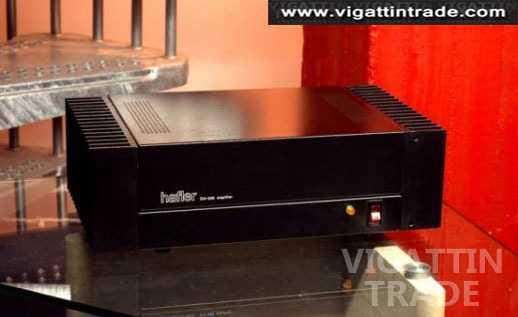DH-200 power amp. HAFLER 2nd hand

Ad Information
Ad Description
CALL&TEXT ONLY IN MY CP# THIS IS MY PERSONAL PRODUCT!
with full modification from musical concepts!
THE CIRCUIT
The DH-200 circuitry is completely complementary push-pull and drives the MOSFETs with conventional bipolar transistors for amplification. An interesting feature afforded by the MOSFET properties is that the DH-200 has none of (nor does it require) the conventional volt-amp limiters, because the MOSFETs act simply as low valued resistors when turned on and have self-limiting properties (no thermal runaway).
The amp uses a fairly heavy power transformer, feeding a 25A full wave bridge, which develops +/- 60V (unregulated) to feed the two channels. For protection it has an AC line fuse, AC line thermal breakers which sense heat sink over-temperature, individual V + and V - fuses to each channel, and within-the-loop speaker fuses. Excessive temperature shuts down the amp altogether and lights the panel indicator (shown in Fig. 1).
Component quality level is consistent with the price asked. This means you see no esoteric parts, aside from MOSFETs. Resistors are mostly carbon film, except for a couple of power wirewounds. Aluminum electrolytics are used for bypassing and signal coupling, and a fairly large number of disc ceramics is also used.
The output binding posts are the finger-busting-to-tighten nickel plated type, and the input jacks are conventional tin-plated phono connectors. High level interconnecting circuits use stranded #18 wires.
BENCH TESTS
On the test bench the DH-200's performance is among the most impressive I have seen. It handles with ease just about everything you throw at it. Since most of my measurements tend to show very low distortion and appear to reveal no particular pattern, I'll summarize most of them focusing on those I feel to be significant in one way or another.
Hum and noise are quite low for both channels, measuring 82.5dB (R) and 85dB (L) below 1 watt with the input open. With a more realistic source termination these figures will improve a few dB. For a 100W output add 20dB to the S/N. As these are wideband measurements, what one actually hears will sound even better with most present-day signal sources. I measured both channels' gain as 26dB, which translates into a nominal 1.4V rms input sensitivity (for a 100W into 8 ohm output).
In short, the DH-200's distortion levels for both THD and SMPTE IM are extremely low. THID, for example, is basically near the residual level of a Sound Technology oscillator/analyzer at all but the highest frequencies and power outputs. At 20kHz at 100W of output it gets as high as 0.013%, and at a 50kHz 100W level it measured 0.04%! For levels from 1 to 100W below 20kHz it remained as a rule well below 0.01%.
That this amp can deliver such clean high level power at frequencies as high as 50kHz is, I am sure, due in large part to the MOSFET output stage. Many bipolar output amps will either self-destruct or melt fuses when asked to deliver 100W above 20kHz; I do not recommend such testing to the inexperienced. The DH-200 appears to shrug off such stresses and happily deliver clean watts.
Compared Ad


